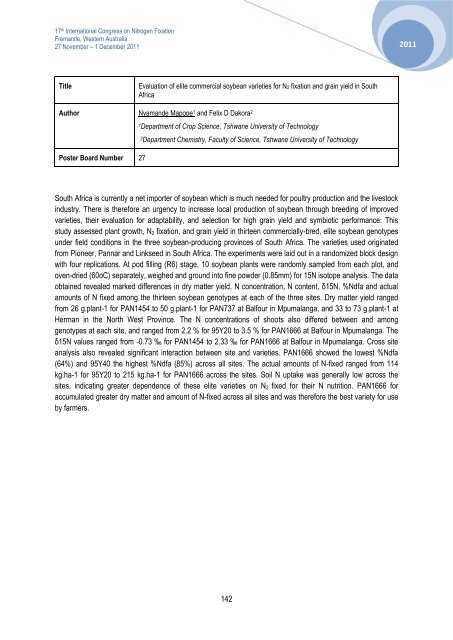IN INOCULANTS Nodulaid - 17th International Nitrogen Fixation ...
IN INOCULANTS Nodulaid - 17th International Nitrogen Fixation ...
IN INOCULANTS Nodulaid - 17th International Nitrogen Fixation ...
You also want an ePaper? Increase the reach of your titles
YUMPU automatically turns print PDFs into web optimized ePapers that Google loves.
17 th <strong>International</strong> Congress on <strong>Nitrogen</strong> <strong>Fixation</strong><br />
Fremantle, Western Australia<br />
27 November – 1 December 2011<br />
Title Evaluation of elite commercial soybean varieties for N2 fixation and grain yield in South<br />
Africa<br />
Author Nyamande Mapope 1 and Felix D Dakora 2<br />
Poster Board Number 27<br />
1 Department of Crop Science, Tshwane University of Technology<br />
2 Department Chemistry, Faculty of Science, Tshwane University of Technology<br />
South Africa is currently a net importer of soybean which is much needed for poultry production and the livestock<br />
industry. There is therefore an urgency to increase local production of soybean through breeding of improved<br />
varieties, their evaluation for adaptability, and selection for high grain yield and symbiotic performance. This<br />
study assessed plant growth, N2 fixation, and grain yield in thirteen commercially-bred, elite soybean genotypes<br />
under field conditions in the three soybean-producing provinces of South Africa. The varieties used originated<br />
from Pioneer, Pannar and Linkseed in South Africa. The experiments were laid out in a randomized block design<br />
with four replications. At pod filling (R6) stage, 10 soybean plants were randomly sampled from each plot, and<br />
oven-dried (60oC) separately, weighed and ground into fine powder (0.85mm) for 15N isotope analysis. The data<br />
obtained revealed marked differences in dry matter yield, N concentration, N content, δ15N, %Ndfa and actual<br />
amounts of N fixed among the thirteen soybean genotypes at each of the three sites. Dry matter yield ranged<br />
from 26 g.plant-1 for PAN1454 to 50 g.plant-1 for PAN737 at Balfour in Mpumalanga, and 33 to 73 g.plant-1 at<br />
Herman in the North West Province. The N concentrations of shoots also differed between and among<br />
genotypes at each site, and ranged from 2.2 % for 95Y20 to 3.5 % for PAN1666 at Balfour in Mpumalanga. The<br />
δ15N values ranged from -0.73 ‰ for PAN1454 to 2.33 ‰ for PAN1666 at Balfour in Mpumalanga. Cross site<br />
analysis also revealed significant interaction between site and varieties. PAN1666 showed the lowest %Ndfa<br />
(64%) and 95Y40 the highest %Ndfa (85%) across all sites. The actual amounts of N-fixed ranged from 114<br />
kg.ha-1 for 95Y20 to 215 kg.ha-1 for PAN1666 across the sites. Soil N uptake was generally low across the<br />
sites, indicating greater dependence of these elite varieties on N2 fixed for their N nutrition. PAN1666 for<br />
accumulated greater dry matter and amount of N-fixed across all sites and was therefore the best variety for use<br />
by farmers.<br />
142<br />
2011


